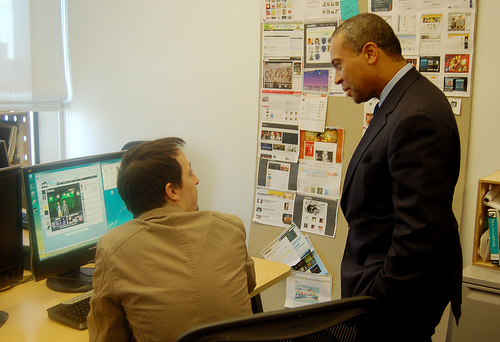


Massachusetts Governor Deval Patrick (right) continues to invest in workforce training to serve high-tech manufacturing companies. How can people with disabilities be included in this effort?
To no one’s surprise, monthly unemployment statistics from the U.S. Department of Labor continued to disappoint. People with disabilities could not even share satisfaction in the minuscule reduction of the unemployment rate from 8.3% to 8.1%. That figure is still better than the 0.3% increase in experienced by this demographic.
Shaun Heasley of Disability Scoop noted the unemployment rate for individuals with disabilities had been increasing all summer long, after dropping below 13% in April and May for only the second time since 2009. He also included the media’s obligatory caveat that the Labor Department’s calculation excludes people who have given up looking for jobs, which makes the numbers even bleaker for both people with and without disabilities during the past month.
Job creation continues to be the top concern of the American public and the central issue of the current presidential campaign. No matter which horse you’re rooting for in that race, most everyone agrees that a greater focus on career training and workforce education is part of the employment solution.
Here in Massachusetts, Governor Deval Patrick’s economic development plan has included funding that helps community colleges repurpose their programs to meet the needs of emerging industries, most notably biotechnology, life sciences, and high-tech manufacturing. Last week, Patrick committed $5 million in state funds to help high-tech manufacturers “improve workforce competitiveness and create workshops to promote capital and technical assistance,” according to State House News Service reporter Matt Murphy.
Murphy’s article, found here in Friday’s Lowell Sun, includes some interesting figures related to manufacturing jobs in Massachusetts. He quotes a report from The Center for Urban and Regional Policy at Northeastern University which says 43 new manufacturing firms started in the state during 2011, and that the number of manufacturing jobs have been stable since 2009.
Both outcomes are the result of efforts to transition the economy toward new sectors of manufacturing. But the continued investment in the workforce is necessary to prevent these jobs from leaving Massachusetts or the United States altogether, says Secretary of Economic Development Greg Bialecki:
We have not had enough young people going into manufacturing so the age of our workforce is high and growing… Of those 250,000 working now, there will be a lot of retirements and attrition in the coming decades and that means we’ll need tens of thousands to go into manufacturing.
As previously noted, high-tech companies in California have benefited from hiring people with disabilities. We also know that work in the manufacturing sector stimulates other types of jobs that can be performed by these individuals, especially with tasks like light assembly, packaging, and order fulfillment. Young or old, there is a population of employees with the skills and experience to help keep the Massachusetts economy on track and maybe even make a dent in those unemployment figures for both people with and without disabilities.
Comments?
Image by Nabeel H.
Wow! This is exactly what I needed today. The way you’ve presented this is simply brilliant – clear, engaging, and full of value. Well done!
good
Great insights on the role of contract services in sustaining manufacturing jobs in Massachusetts! Leveraging specialized services can help businesses stay competitive while maintaining local employment. Efficient data management also plays a key role in optimizing operations—tools like Terabox can support secure storage and accessibility, ensuring seamless workflows. Thanks for sharing this valuable perspective!
Great insights on the importance of contract services in sustaining local manufacturing jobs. Outsourcing certain processes can enhance efficiency while keeping core operations strong. A similar approach applies in various industries like how Carx Street leverages strategic partnerships to optimize performance. Thanks for sharing this perspective!
Great insights on the importance of contract services in sustaining manufacturing jobs in Massachusetts! Leveraging specialized support can definitely help businesses stay competitive. Speaking of strategic planning, I recently explored Bitlife, which offers interesting perspectives on resource management and decision-making—key aspects in manufacturing as well. Thanks for sharing this!
Great insights on the role of contract services in sustaining manufacturing jobs in Massachusetts! Outsourcing certain tasks while keeping core operations local can be a smart strategy for businesses. Similarly, industries like gaming have evolved through innovative platforms—just like 3 patti games, which continue to engage players globally. Balancing in-house expertise with external support can drive growth effectively
Great insights on supporting local manufacturing jobs! Contract services can indeed provide flexibility and cost efficiency, helping businesses stay competitive. Ensuring strong cybersecurity measures is also crucial in maintaining smooth operations—tools like smadav can help protect sensitive data from threats. Thanks for shedding light on this important topic!
Want to enjoy Brawl Stars without any limitations? Nulls Brawl gives you access to unlimited gems, all brawlers unlocked, and exciting new mods. Download now and dominate the game like never before!